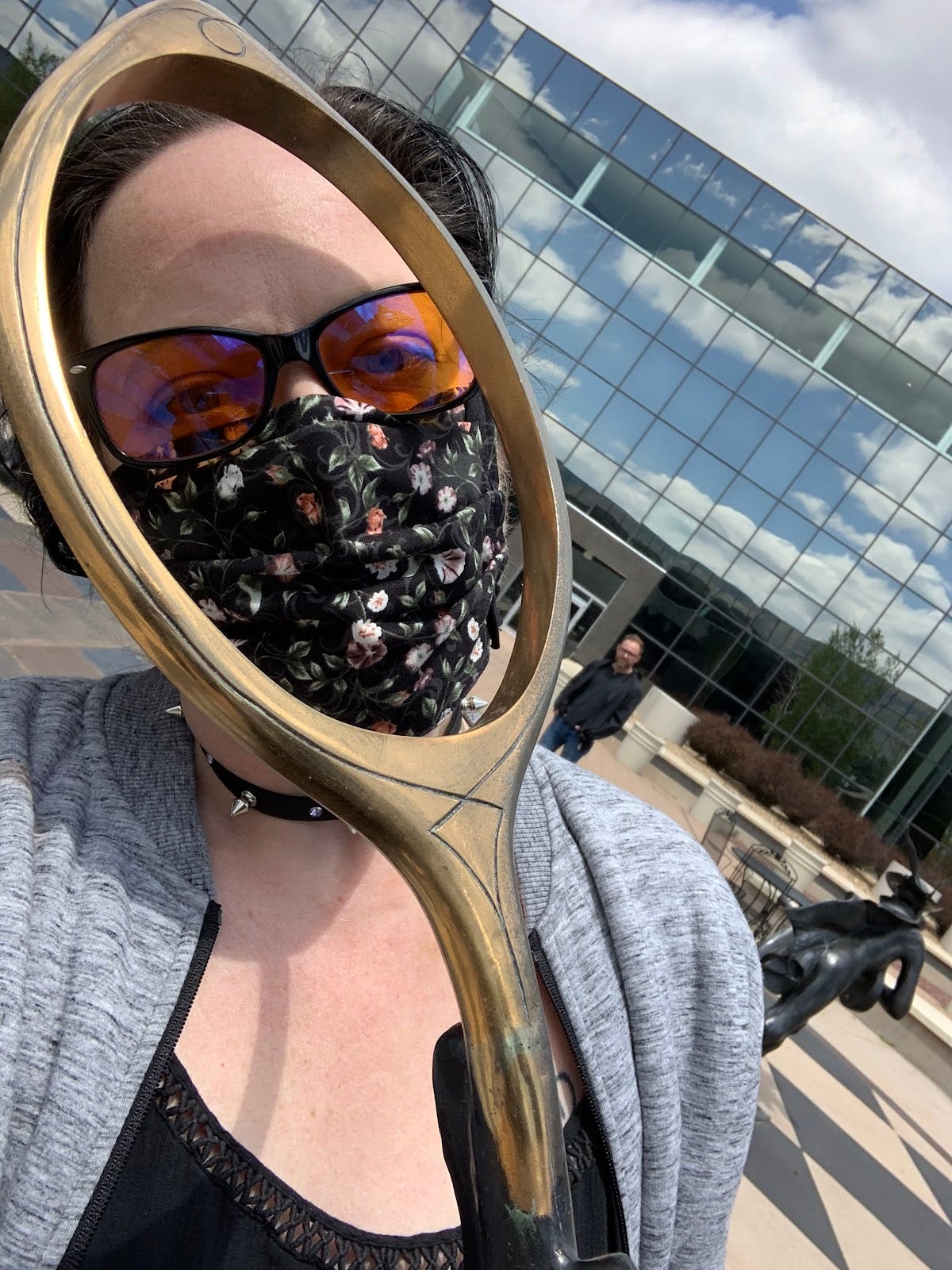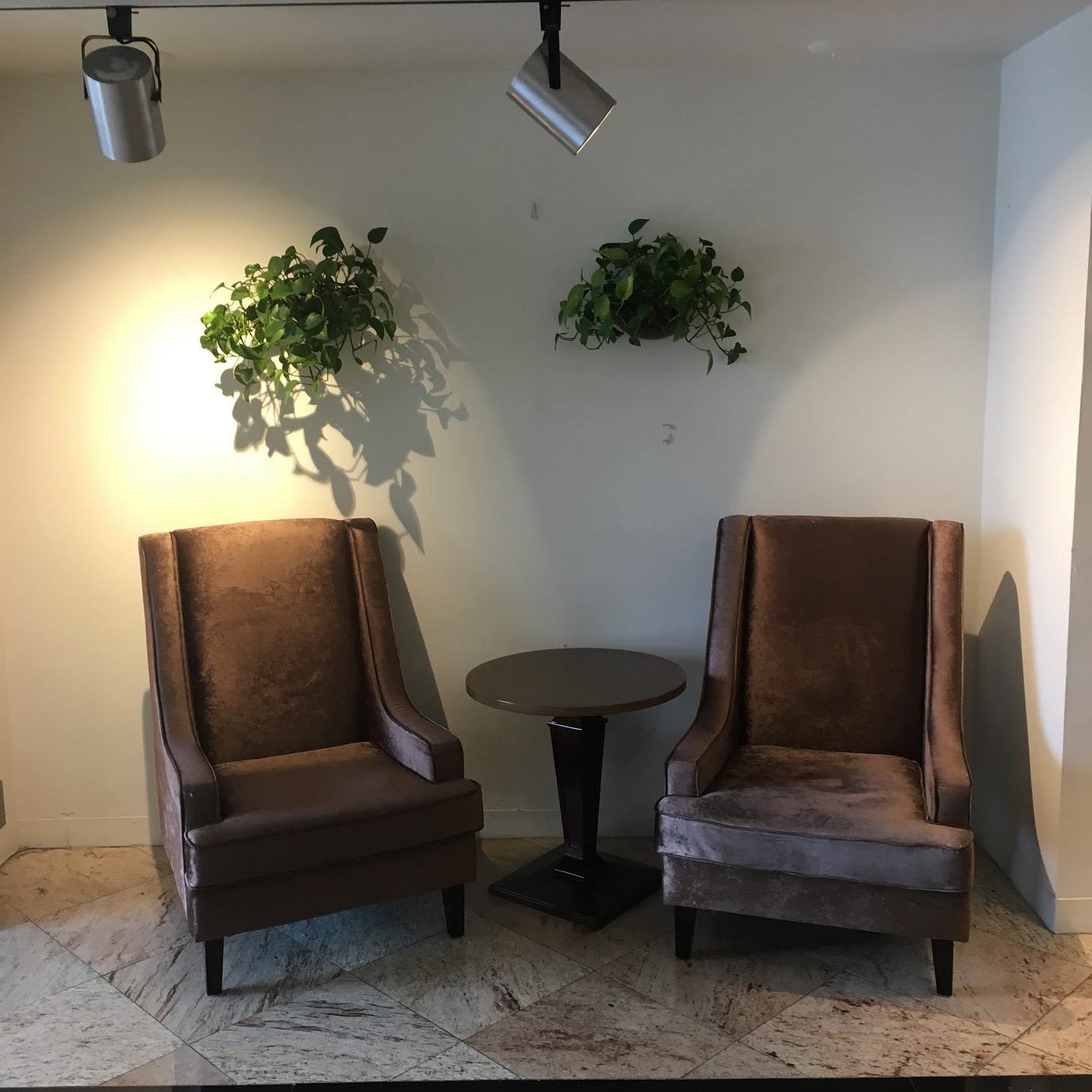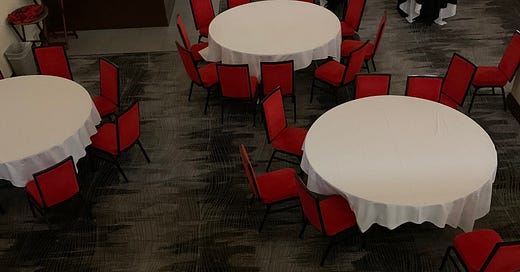I discovered the concept of 3rd places during the pandemic lockdown I think because of kenopsia, though I’d never heard the word before now. I came to 3rd places through a fascinating linguistics book called Because Internet, and continued my research with the original Great Good Place and other studies. Connected to that concept was a vocab word I’d uncovered before: Desire Paths. I can’t quite explain why I connect my fascination with desire paths to 3rd places, but it seems to me that desire paths are almost more in line with this new (to me) concept of kenopsia–a trace left of a formerly-humanly occupied space. A melancholy leaving, a hollowed-out shape, a scar left in an emptiness that used to be full of life.
This exciting article from newsletter lol/sos with its multiple vocab words introduced me to today’s vocab word: kenopsia. Kenopsia is a sentiment that I think explains my pandemic (& further) obsession with 3rd places, and it strikes me as important and still latent in our collective psyche today. A lot of us are haunted by kenopsia, I think, after the pandemic lockdown experience. The ghost-towning of so much of the world, that hasn’t all come back to full life quite yet, and some of these kenopsia-inducing spaces maybe never will.
A concoction from the Greek “kenosis” (emptiness) and “opsia” (seeing), kenopsia refers to the “eerie, forlorn atmosphere of a place that was once bustling with activity but is now abandoned and empty.”
The adjectives used in the above definition are: ‘eerie’, and ‘forlorn’. I’d add ‘melancholic’ to those. There’s something aching and sad about witnessing these emptinesses, and almost a longing for a refilling of the space we see. I’ve been noticing a lot of memes constructed around the word Hiraeth, too, which is a sort of similar idea–that of a longing for something bygone, or that maybe never was. A home that we can never return to or that maybe never existed, but still fills us with nostalgic longing. We’re all feeling this viral strain of sadness I think, in the wake of being isolated for so long during lockdown, and still afraid.
An Empty Mirror
Right before Covid burst onto the scene and the ensuing pandemic forced us into lockdown, I was living in two places, pretty much. Most of the time I lived in the Birdhouse close to downtown Boulder, traveling by public transportation 2-3 times a week to downtown Denver to teach. On the days when my partner’s kids were at their mom’s, though, I’d stay with him. So I’d basically be on the opposite of their 50/50 custody schedule.
In March of 2020, the university told us to not come back after Spring Break, but to conduct the rest of the semester online, because of the new virus. And there was hushed talk of a possible shelter in place order. I was on the bus on my way back to the Birdhouse at that time, and Partner texted me in a quiet panic that I could smell emanating from my message app:
Turn around, he texted. Come right back. Pack a couple weeks’ worth of clothes and take the next bus back here. Don’t even stop at a pub. They're going to shut the buses down soon.
I responded: Do you really think they’ll stop all the buses, just like that? (Reader: they did indeed, mere hours after I’d arrived back at Partner’s place.)
And so, there we were, celebrating St Patty’s day not out at a pub for the first time. They’d locked everything down, stopped public transportation, and shut doors statewide by that evening. Partner and I put on a couple of his scally caps and sipped whiskey on the long balcony of his apartment. Little did I predict how many hours of how many days I’d end up working and taking the air and attempting to salvage my sanity in a lounge chair on that balcony. I’d attend Zoom calls, grade online assignments, and watch as the families of the complex began gathering for impromptu outdoor block parties, evolving into lovely little (well, big actually) pandemic pod parties. Again, obviously to salvage sanity—those little kids needed to run around some or everyone’d be insane by next month.
Another thing we’d do during lockdown was amble around the neighborhood. We’d take longish walks down and around the smooth sidewalks that used to be paced by office workers on their lunch breaks, or consultants on their phones. Partner’s neighborhood is very much about office buildings and corporate campuses, and so when lockdown happened, the whole area got shockingly emptied. We’d walk, masks ready at our necks in case we came across another living being, past countless deserted office buildings made of glass and silence, through flat parking lots reverberating with space, and once, found a weird little sculpture garden in a concealed courtyard of one of these abandoned offices, that we surely would have been kicked off of for trespassing if not for the fact that there was absolutely no one there. What made it even more weird was its theme: bronze commedia figures big as life, holding mirrors that were filled not with silvered glass, but empty space.

An Echoing Hallway
When Gretchen McCulloch (of Because Internet) discussed the populations of academic hallways in conferences and other classroom buildings being a vibrant row of 3rd places, I knew exactly what she was talking about, because of the short stretch of hallway in front of room 271 and the Theatre and Dance department office, in the Arts building on Auraria Campus.
Room 271 was that acting studio classroom all theatre programs have—the one that has real fresnels or other theatrical lighting that may or may not actually work, that’s all painted one color (usually black) and that stores a plethora of plywood boxes of various kinds, out of which all sorts of sets are created, with a combination of Tetris skills and imagination. ARTS 271, to any theatre kid in that department, is their second home, or Third Place. I had one when I was earning my BFA at another university in Boulder, too–it was called The Studio, and to this day I don’t actually know what the room number was. 210, maybe? Nah, it’s The Studio.
And of course the 3rd place aspect wasn’t just in the room itself, it actually mostly encompassed the stretch of hallway in front of it. If you think about it, inside the classroom was more of a 2nd place (work), whereas the shortish stretch of hallway outside it, facing the Theatre department office and the grey affiliate faculty cubicle on the other side, was the 3rd place hub of theatrical social activity during a busy semester. The hallway was the place where students would sit on the hall-side benches and eat their snacks and lunches between classes, mostly held in 271 if they weren’t around the corner in 249. During any breaks between classes, that few-doors-long stretch of hallway would teem with (mostly) college kids eating snacks, sipping coffee, and of course, talking. Conversation is the anchor of any 3rd place, and the ARTS 271 hallway illustrated this.
This hallway was such a treasured place that one of the faculty took it upon himself to erect a Zoom version of the hall for everyone to appear at when they wanted to, for a few hours each afternoon during lockdown in 2020 when we weren’t allowed to go anywhere, least of all to campus. Many students did so, as did I and one or two others of the faculty once in a while. They’d pop up in their little Zoom boxes and chat and snack and chat some more and rehearse and get advising and do everything they’d do if they were really there. Which, I guess they were, in a way.
How empty that hallway looked, though, the day I quit.
The Arts building was under construction and renovation during the time of that meeting, so it already had a weird liminal vibe. I was leaving somewhere that had been a vital place for me for two decades, now all dismantled and different. And empty. It had been, of course, utterly deserted during the lockdowns and pandemic restrictions, but even though campus was ostensibly back open, it was still eerily deserted. There were no students hanging out there after finals week, anyway, and that day as I left that last faculty meeting, I saw no recognizable landmarks that weren’t buried under scaffolding or forever changed to be made more modern. Some of this was in a good way—the classroom where I always taught Intro to Theatre was so old and decrepit, it had a green chalkboard instead of a white dry-erase board, and forget trying to get any computer or device online in that room. So in that case, I was glad to see some upgrades and changes. But it wasn’t an unalloyed joy I felt, walking through that between-stages hallway, down those oh-so-familiar stairs past the digital department billboard where my face still cycled through with all my colleagues and past productions. And the silence. Echoing and even mirroring the silence of the faculty at the meeting when I’d quit. Too quiet, too still.

Not Your Acting Teacher’s Empty Space
Empty gathering places are always eerie in human lore–everybody knows that zombies live in abandoned malls. And shut-down amusement parks? That’s the setting for many a horror game or movie–there’s that one where the clown-masked murderous creature comes after you in a locked carnival booth–what was that one called? And of course, the terrifying premise of Five Nights at Freddy’s has to do with a deserted Chuck E. Cheese type place. When and how does kenopsia change from eerie melancholy into horror?
What else is a haunted house, indeed, but a place that used to be bustling and alive, maybe some horrible crime happened there, and now contains only empty spaces? Those empty spaces in that case don’t get filled with the longing of kenopsia, but with actual ghosts.
There was a haunted house that lived right in the middle streetside of the trailer park where I grew up—it was towering and Victorianly ornate, in stark contrast with the standardized tin cans where we lived. Nobody lived in that house as long as I was there, and its doors were always bolted and its windows boarded up. Dust and spiderwebs and a palpable stillness surrounded and filled it. Many years later, they painted it over in pale green (instead of the dark brown and cream it was when it was haunted). It was also renovated, I hear, and populated? Maybe?… it’s mysterious. Hard to know. I hear it’s for sale now–the whole outer haunted structure now containing 7 apartment units. Hm. Does this make it a liminal space or a kenopsian one? I’d say it was more liminal, as I don’t believe in its ever being bustling and vital.
There’s something stunning about the idea of an “emotional afterimage” of a place—the emotional traces of the life that was there, a mark left behind to echo in the emptiness. A soot stain of life now gone. Kenopsia is about our witnessing of this, and perhaps longing for that liveliness to return. Or perhaps just mourning its absence.

Liminal Kenopsia
Liminal spaces are a different monster, though, I’d say. The lol/sos article above talks about liminal spaces as being in a “state of transition”; in other words, it’s a space that’s in between one state and another. The pull of liminal spaces, the author says, is in their potential.
I disagree with this actually—liminal spaces to me look like spaces that not only have never been filled, but never will be. I don’t see the potential of population in any liminal spaces. Their mystery lies in the idea that they were never designed for human population. They’re weirdly empty because they’ve never been occupied and never will be, and maybe they’re even built with non-Euclidean geometry a la Lovecrafitan madness-inducing corners. Liminal spaces are ghostly in a dead way, in other words, whereas kenopsia comes from the absence of a vibrancy that once populated a place. It’s a place that used to be alive, that now resonates with empty spaces left behind by those who used to occupy them. Liminal spaces ain’t that. They occupy a dimension between.
Kenclusionopsia
What places are like this for you? Can you think of an empty spot that gives you feelings of kenopsia? I can think of a few in my world here in Denver, especially downtown but kind of everywhere–bars that have remained empty, instead of filled up with new stuff. Though sometimes the new stuff to me gives off a different sort of sense of kenopsia, depending on how dead the new stuff feels as compared to what the place used to be.






I love all the places you travel in this piece, Jenn - I won’t say the journey offers liminal space for my own thoughts, because I like your contrarian definition of “liminal.” But there are thresholds here and so many emotional after images. And you do bring back the pandemic, in all its kenopsian melancholy. Here’s what I wrote about Harvard Square in March 2020:
“I headed into the cold wind down Mass. Ave., noting only a few passersby and cars on the street at rush hour. At rush hour? There were empty buses lined up. I’d been beating back my own sadness for days, but the chilly loneliness of an urban tourist spot with no people brought a whiff of despair, which was worse. I imagined cardboard boxes or tumbleweeds blowing down the avenue, as if the apocalypse had already happened.”
From https://talkingwriting.com/dreams-escape
Not really. Some of it is due to better cars and roads which makes it easier to travel farther for things you need. Some of its loss of industries or just consolidation of farms by agro businesses. And often even if the town thrives (like my old home town) it’s irrevocably changed by gentrification (my old home town is still very small but has some of the highest home prices in the country).
We stopped being a rural nation some time after WW2 and the trend has only accelerated. It’s too bad since many people no longer have any rural connection. And as we used to say when I was a kid “Farming is everyone’s bread and butter.”